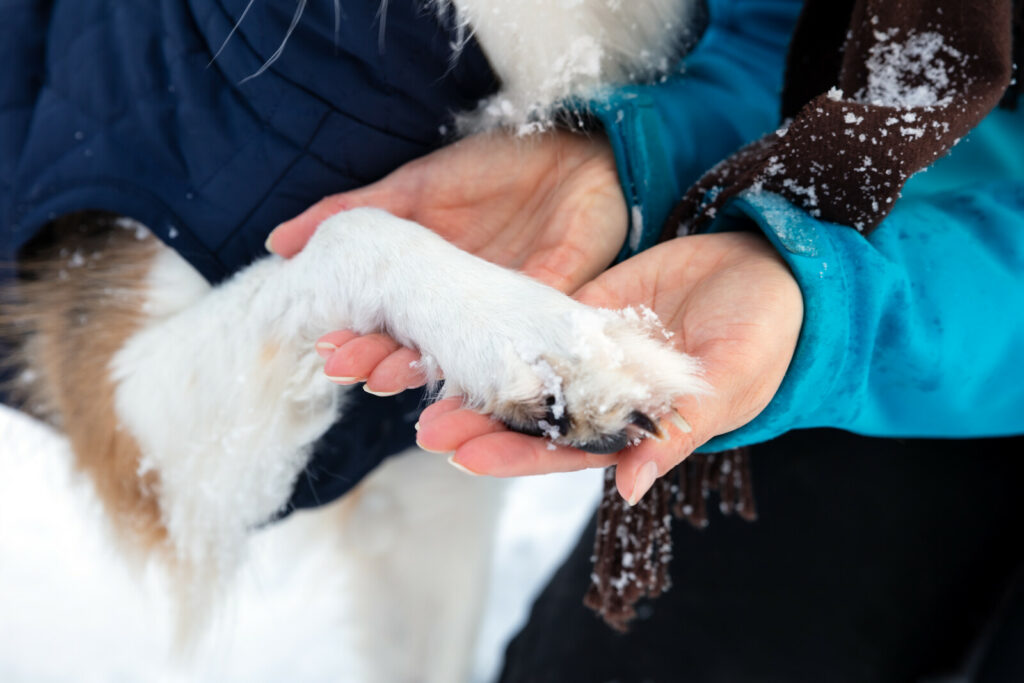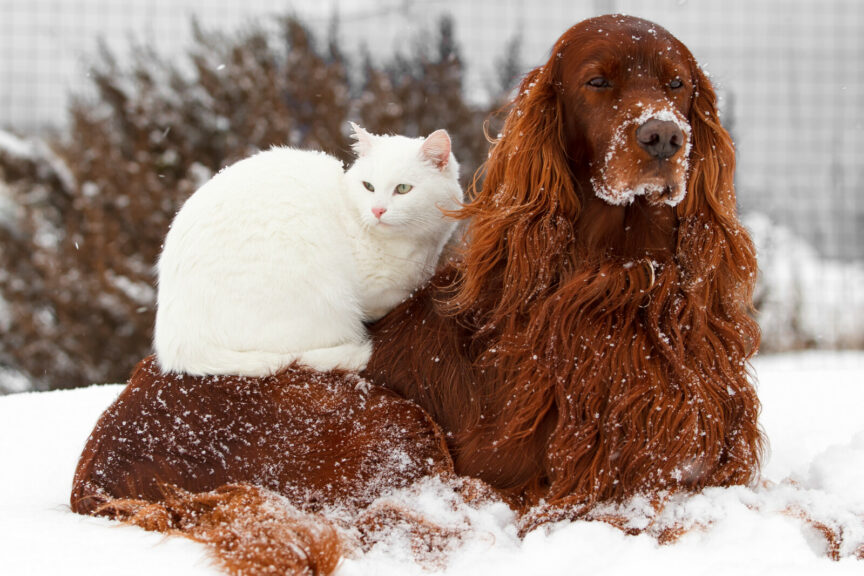Brrr! Impact of Icy Cold Can Have on Dogs and Cats Outdoors
During the summer, we experienced 67 consecutive days of temperatures above 100 degrees in Dallas, TX. Other parts of the country also recorded heatwaves. And, now, as we enter the first month of January, the wind chill makes the temperature feel like 5 below zero.
And, we are far from unique. An arctic blast of ice, snow and sub-zero temperatures are blanketing much of the country. That’s why I wish to focus on two topics for this blog: caring for our dogs on outdoor walks and potty breaks, and reaching out to help community cats who are seeking food, unfrozen water to drink and shelter from the chilly winds.
Keeping Dogs Safe on Wintry Walks

Exposure to cold temperature can quickly drop the body temperature in cats and dogs, whose healthy temperature ranges between 99.5- and 102.5-degrees Fahrenheit. When the body’s temperature drops below 98 degrees, hypothermia occurs.
Here are the warning signs of mild to moderate hypothermia in dogs and cats:
- Shivering
- Pale to whitish gums
- Walking stiff or clumsily
- Acting confused
Unchecked, the heart lows down, breathing becomes more labored and oxygen levels drop in the bloodstream, causing potentially shock, organ shutdown and even death.
First, let’s focus on our dogs. Depending on your dog’s coat and level of exposure outdoors during cold weather, consider fitting him with a coat to keep in his body warmth. My terrier mix, Kona, and my poodle-chihuahua mix, Emma sit at the back door as I fit them in their pet coats that keep them warm without restricting their leg movement.
Extra care must be taken to protect their paw pads as well. You certainly would not willingly be walking outside during a snow storm in bare feet as your toes would be aching from the cold very quickly.
The pads on our dogs’ feet act like shoes, but they are definitely need protection again the ice, deicing chemicals and snow on shoveled sidewalks. Based on your dog’s tolerance, I recommend these safety options:
- Paw balm. Look for these paw-protecting products designed to coat the paws before going outside and being exposed to salt and ice. Make sure the balm is made specifically for dogs. You can also coat each paw in a petroleum-jelly product, such as Vaseline, before each outing to keep the paws coated and moisturized.
- Booties. Some, not all, dogs will tolerate wearing these protective coverings on outdoor walks, especially if they are fitted properly. Booties offer warmth and added stability on icy surfaces.
- Warm water and a towel. Keep walks and potty times short during extreme cold temperatures. And, when returning inside, carefully rinse away ice and deicing chemicals from each paw by placing each paw under warm – not hot – water from the kitchen sink or shower, depending on the size of your dog. Then take a dry towel and carefully dab the paw dry. Be careful not to try to scrap off the ice on the paws as you risk creating abrasions and opening up the body to infections.
Aiding Community Cats
In our Dallas neighborhood, much like other places throughout the country, there is a community cat colony. These are cats who live outdoors, but many who have been humanely trapped, neutered, vaccinated and released back to their neighborhoods. These cats often sport left-tipped ears to indicate they have been sterilized and vaccinated.
As resourceful as these cats may be, they can benefit from our extra help during cold weather. Consider these options:
Provide bowls of water on your porch in safely heated containers to prevent the water from freezing.
Offer bowls of kibble, striving to fill them around the same time each day or night as these cats seem to wear ‘invisible watches’ and learn when feeding times occur. Kibble takes longer to freeze than canned food.
Once a week, we also offer bowls of shredded boiled chicken free of any bones, skin or seasoning for a protein boost.
Build or buy a wooden outdoor cat shelter and locate it on your porch or other area protected from the wind, rain and sleet. Make it has a door flap. Do not line with thick towels or blankets that can freeze. Instead, line with mylar blankets or straw. You can also pack large pillowcases with shredded newspapers or packing peanuts and place tuck them in areas that are out of the wind. Be sure to re-stuff these pillowcases to keep them clean.
If possible, include a pet-safe heating pad set on low and plugged into a safe outdoor outlet. Lure the cats to this shelter by sprinkling it with catnip or silver vine.
Mother Nature definitely calls the shots when it comes to weather extremes. But you can play your part in keeping our dogs and outdoor cats a bit safer by exercising some of these above tips.
Learn Pet First Aid
Learn more on ways to keep your cats and dogs safe by visiting http://www.propethero.com. Consider taking our veterinarian-approved online pet first aid/CPR course. Enter this code: CPR – ARDEN MOORE and receive a 10 percent discount! And, if you are interested in becoming a Pro Pet Hero instructor, please click on the BECOME AN INSTRUCTOR button on the home page for more details.

